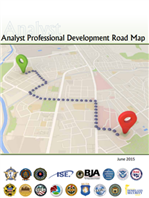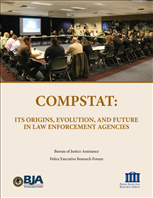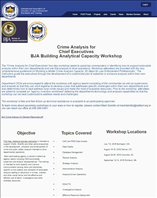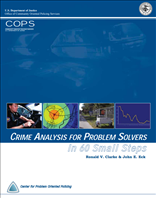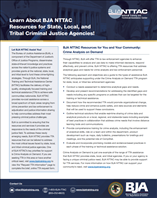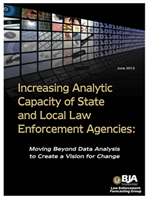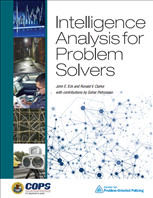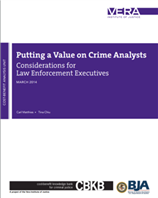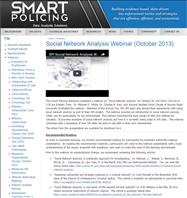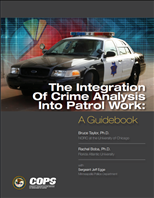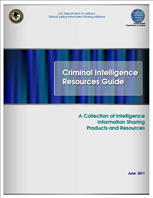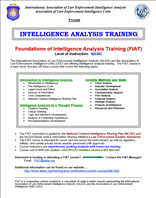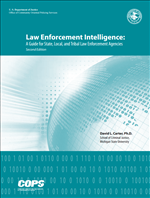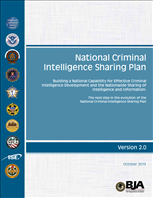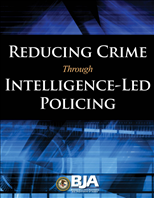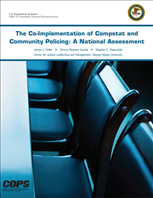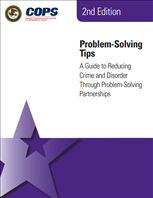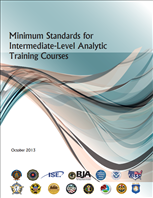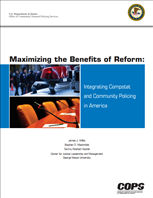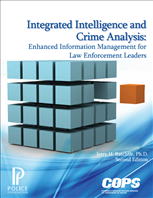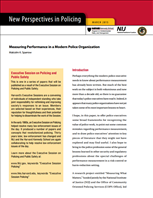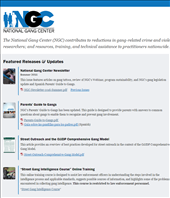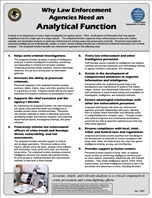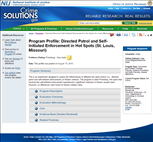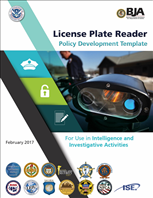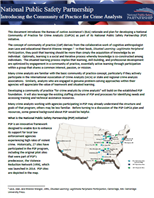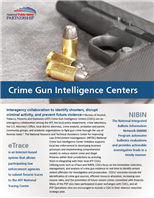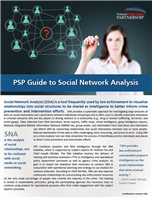Analyst Professional Development Road Map
To support law enforcement leadership as they continue to hire and train analysts, the Analyst Professional Development Road Map (Road Map) was developed. The purpose of the Road Map is to create a sustainable, professional career path for analysts operating within state, local, tribal, and territorial organizations. This path focuses on the development and enhancement of analytic-related knowledge, skills, and abilities over three overarching analyst levels (basic, intermediate, and advanced) and the training recommended for achieving each level. In the context of this document, the term "analyst" typically refers to an individual serving in an intelligence analyst position; however, other analysts, including crime analysts, are encouraged to use this guidance as appropriate.
BJA Crime Analysis on Demand Resources
The Bureau of Justice Assistance (BJA) recognizes the enormous benefit a healthy crime analysis capacity can bring to law enforcement agencies. To increase crime analysis capacity nationally, BJA funds guidance, training, and technical assistance designed to directly support and assist state, local, and tribal law enforcement agencies in increasing their crime analysis capacity.
Compstat: Its Origins, Evolution, and Future in Law Enforcement Agencies
This publication presents the findings of an effort to assess the status of Compstat in local and state law enforcement agencies. The project was initiated with the goal of studying the initial development and evolution of Compstat, identifying current best practices, and analyzing the future of Compstat. The project consisted of three primary components—a survey of PERF member agencies, an executive session, and site visits and interviews with representatives of law enforcement agencies using Compstat.
Crime Analysis for Chief Executives Building Analytical Capacity Workshop
BJA, in partnership with the International Association of Directors of Law Enforcement Standards and Training (IADLEST), provides a series of two-day regional and online workshops in which agency teams, including agency executives, commanders, and analysts, create customized action plans to address specific crime analysis challenges within their departments. This workshop will assist top commanders and their teams in identifying how to support actionable analysis within their own departments and use that analysis to drive operations. As part of the workshop, attendees will receive the comprehensive guidebook Building a Model Crime Analysis Capability: 50 Steps for Law Enforcement Professionals.
Crime Analysis for Problem Solvers In 60 Small Steps
The most immediate goal of the manual is to help the relatively small number of individuals now commonly employed in police agencies as crime analysts to expand their function and thereby contribute more to the effectiveness of their agency's operations. It is intended, more ambitiously, to contribute to the training of new crime analysts or problem-solvers, to increasing their number, and to their development as a distinct and vital profession. But problem analysis is not the exclusive domain of technicians. We hope that, everyone else in a police agency, from officers on the beat to police executives, and, more broadly, those in both the public and private sector concerned about crime, will incorporate the line of thinking set forth in the manual into the perspectives they bring to their work.
Crime Analysis on Demand Training and Technical Assistance
The BJA National Training and Technical Assistance Center (NTTAC) promotes the BJA mission by facilitating the delivery of high-quality, strategically focused TTA to achieve safe communities nationwide. The NTTAC has identified expert providers to deliver high-quality services and products that address analytical gaps and needs for crime analysts and law enforcement personnel.
Increasing Analytic Capacity of State and Local Law Enforcement Agencies
Analysis has been a part of American policing for more than a century. Evolving from pin mapping to comparative data tables; from simple patterns analysis and batch processing on mainframe computers to user interface with real-time analysis; and eventually to more flexible and sophisticated analysis, such as the Geographic Information System (GIS), law enforcement has used a variety of analytics to respond to crime. After the terrorist attacks of September 11, 2001, the need for more robust intelligence capabilities and analytic capacity at the state and local law enforcement levels became more apparent than ever before.
Increasing Crime Analysis Capacity
The Police Foundation and the International Association of Crime Analysts (IACA) invite law enforcement executives to a highly informative symposium that will provide them an overview of crime analysis best practices and organizational considerations necessary to integrate crime analysis and evidence-based policing strategies into their agencies' everyday practices, making them more effective and efficient in reducing crime in their communities. In a one-day symposium, executives will be shown how to focus their use of crime analysis by matching the appropriate type of analysis to the appropriate rank and division in the agency, so that crime reduction at all levels is informed by actionable crime analysis.
Intelligence Analysis for Problem Solvers
Knowing how intelligence analysis can help solve problems and how problem-solving can improve the effectiveness of intelligence analysis will aid any police practitioner interested in reducing crime or disorder. This manual fuses aspects of intelligence analysis with Problem-Oriented Policing. It is focused on the analysis of intelligence and has been written for three groups in local policing agencies: (1) intelligence officers and analysts, (2) crime analysts who may be called upon to use intelligence information and, (3) police managers who supervise crime and intelligence analysts.
Putting a Value on Crime Analysts: Considerations for Law Enforcement Executives
BJA, in partnership with the Vera Institute, developed guidance so law enforcement executives may understand how an investment in crime analysts contributes to the goals and mission of policing, via the execution of a costbenefit analysis.
Social Network Analysis Webinar
The Smart Policing Initiative (SPI) presented a Webinar on "Social Network Analysis" facilitated by Dr. Michael D. White, Dr. Charles M. Katz, and doctoral student David Choate of Arizona State University. Members of the Kansas City, Missouri SPI team also shared their experiences with using social network analysis as part of their SPI project. The Webinar provides an introduction to social network analysis (SNA) and its applicability for law enforcement. We also direct your attention to a blog post that speaks to how the Kansas City, MO Police Department is Reducing Homicide Using Social Network Analysis. You can locate the post at the following link: https://www.ojpdiagnosticcenter.org/blog/reducing-homicides-using-social-network-analysis
The Integration of Crime Analysis Into Patrol Work: A Guidebook
This guidebook has been developed for mid-level managers and commanders of police agencies who are looking for guidance in fully incorporating crime analysis into their agency, particularly into patrol. The guide presents a series of considerations and recommendations for crime analysis integration, provides crime analysis product examples that have been implemented into innovative police agencies around the United States, discusses key issues of implementation, and outlines an implementation framework strategy.
Targeting Offenders
The Smart Policing Initiative presented a Webinar on "Targeting Offenders." Scott Decker, Ph.D., the Director of the School of Criminology and Criminal Justice at Arizona State University and a subject-matter expert with the SPI Team, facilitated this online seminar. He touched on how to identify high-risk offenders, how to implement targeting strategies and related challenges and prospects, and how research and technology can be applied to targeting offenders.
Criminal Intelligence Resources Guide
The U.S. Department of Justice's Global Justice Information Sharing Initiative (Global), its working groups, and partner agencies and organizations have developed many valuable resources that assist law enforcement intelligence personnel in improving agency operations and criminal intelligence sharing efforts. To centrally locate these resources so as to provide the law enforcement intelligence community with a single reference to "all things intelligence" is an ongoing challenge. As such, the Criminal Intelligence Resources Guide was created to address this need. While this document does not claim to be the all-encompassing guide to intelligence products, it does aim to capture a valuable representation of the intelligence-related resources available to the intelligence community. This document is considered to be a "living document," and persistent effort will be employed to continually update it as new resources are identified.
Foundations of Intelligence Analysis Training (FIAT)
The FIAT is a five-day introduction to the basics of law enforcement intelligence analysis. As the name indicates, the FIAT Program aims to provide a foundation, a basic knowledge and understanding, of the elements of the law enforcement analysis profession. It was designed to be an entry-level curriculum.
Intelligence Writing and Briefing
Intelligence Writing and Briefing, a U.S. Department of Homeland Security(DHS)/FEMA grant-funded project, addresses the demonstrated need for fusion centers and other analysts to produce high-quality intelligence reports and briefings. This three-day course is for state, local, and tribal law enforcement and regulatory agency personnel. The training includes basic intelligence writing and briefing principles and methods to facilitate increased intelligence sharing.
Law Enforcement Intelligence: A Guide for State, Local, and Tribal Law Enforcement Agencies
Law Enforcement Intelligence: A Guide for State, Local, and Tribal Law Enforcement Agencies is a policy oriented review of current initiatives, national standards, and best practices. This Guide is intended to support policy in law enforcement agencies and seeks to objectively provide the best knowledge and practice of law enforcement intelligence at the time of publication. It is not meant as an academic work nor does it look at theoretical issues or arguments. It is not directed as a guide to the intelligence community except to explain the roles, responsibilities, and restrictions of the intelligence community's state, local, and tribal law enforcement partners.
National Criminal Intelligence Sharing Plan – Version 2.0
Over the last ten years, the National Criminal Intelligence Sharing Plan (NCISP) has assisted law enforcement agencies across the United States in making modifications and enhancements to their internal business processes to facilitate the availability, accessibility, and flow of criminal intelligence. The results of this widespread implementation have been improvements in the collection of information, the analysis of this information, and the sharing of criminal intelligence. However, with an evolving crime outlook both in the homeland and internationally, it is imperative to review long-standing recommendations to identify new opportunities and approaches that promote continued nationwide criminal intelligence sharing. Thus, in 2013 the decade-old NCISP was reviewed and enhanced, resulting in the release of version 2.0.
Reducing Crime Through Intelligence-Led Policing
Through the Targeting Violent Crime Initiative, the Bureau of Justice Assistance (BJA), Office of Justice Programs, U.S. Department of Justice, has identified numerous law enforcement agencies throughout the United States that have experienced tremendous success in combating complex crime problems plaguing their communities. A cornerstone of these agencies’ efforts appears to be the incorporation of intelligence-led policing, along with other initiatives, to address their crime problems.
Tactical Analytical Products
RISS analysts develop specialized analytical products for investigators and prosecutors to increase their ability to identify, detect, and apprehend suspects, as well as to enhance prosecutorial success in court. These products include highly complex and specialized flowcharts, link-analysis charts, crime scene diagrams, and telephone toll analysis reports, as well as financial analysis reports, computer forensic analyses, and audio/video enhancement services. Digital forensics focuses on the analysis and retrieval of information from computers and digital storage media. Digital forensics analysts uncover deleted files; locate evidence; evaluate the structure of computerized files; analyze other computer and cellular phone activity within hard drives, CD-ROMs, and JPEG images; and analyze e-mail seized during investigations. Audio and video enhancements have become extremely common inside the courtroom and serve as a finite way of assisting law enforcement and prosecutors in convicting criminals. The enhancement of audio bites or video footage assists law enforcement in identifying suspects. Audio enhancements are useful for undercover operations because analysts have the ability to remove background and frequency noise, enabling investigators to clearly identify the suspects. Analysts have the ability to enhance video footage in order to present a clear picture, which is extremely useful in robbery and burglary cases.
Identifying Hot Spots of Juvenile Offending
This guide provides an overview of the procedures developed by the CEBCP in collaboration with the Seattle Police Department to identify and map hot spots of juvenile offending. It is intended as a resource for relatively experienced crime analysts who are familiar with extracting CAD/RMS data to conduct hot spot analysis and to enable them to tailor their analyses to juvenile offending issues. If possible, analysts who are less familiar with these procedures should seek assistance from department or municipal IT staff to enhance analysts' capacity to extract and analyze requisite data. This guide also explains why juvenile offending hot spots should be examined separately and then provides information about the procedures the CEBCP employed to extract and process the relevant data for this research project and the Seattle Police Department.
Social Media and Tactical Considerations For Law Enforcement
The 21st century is becoming known as an Age of Technology, and one of the most important and complex types of new technology is social media. At its core, social media is a tool for communication that has become an integral part of daily life for people of all ages. Social media accounts for 22 percent of time spent on the Internet, and even among people age 65 and older—who are not generally considered prime users of new technologies—one in four people are now active on a social media Web site. Facebook claimed to have 955 million monthly active users worldwide at the end of June 2012.
Awareness Brief: Twitter and Violent Extremism
Although individuals and organizations worldwide use Twitter for a variety of legitimate reasons, violent extremists, gangs, and terrorist groups use it to connect with their supports.
VRN Webinar: Social Media Analysis (resource)
Social media plays a valuable role in allowing people, businesses, and organizations to keep in touch and interact with one another in ways as never before. Unfortunately, social media can also be used by individuals to espouse criminal intentions, coordinate criminal activities, and even publicize acts of violence. This Webinar orients the audience with tools, methods, and techniques to search for subjects, issues, or people on any number of social media sites. Participants also generate a more complete understanding of the concept and function of these sites, how some sites support analysis while others support targeting, and how social media tools and resources can be used to prevent, mitigate, respond to, and investigate criminal activity. By forming a more complete understanding of social media-associated investigative tools and techniques, law enforcement may be better equipped to gather timely information in the furtherance of crime prevention and the investigation of criminal activity. This Webinar is considered law enforcement sensitive and is not publicly available. The open source social media analysis tools discussed during this Webinar are available via this resource.
The Co-Implementation of Compstat and Community Policing: A National Assessment
This report presents findings from the first national assessment of Compstat (CS) and community policing (CP) as co-implemented reforms. Given that systematic research on the co-implementation of CS and CP is scarce, the first purpose of this project was to illuminate the current state of implementation of each reform in the United States and the nature and extent of compatibility problems. Thus, we begin by drawing on data from our national survey to provide a profile of CS and CP in large police agencies. The purpose of the profile is to show what local police departments were doing with each reform, why they decided to adopt them, what some of the differences were between co-implementing and CP-only departments, and what some of the benefits and challenges were that arose from operating both reforms simultaneously.
Implementing a Comprehensive Performance Management Approach in Community Policing Organizations: An Executive Guidebook
This publication is a guide for police executives who wish to institutionalize community policing in their organization through performance management strategies. This guidebook demonstrates how to incorporate principles of procedural justice into performance management systems.
Problem-Solving Tips: A Guide to Reducing Crime and Disorder through Problem-Solving Partnerships
Intended as a reference for those who are interested in implementing a problem-solving approach, Problem-Solving Tips: A Guide to Reducing Crime and Disorder Through Problem-Solving Partnerships contains information and insights into the process. It will take you step by step through solving problems, offer examples of problem solving from the field, and provide additional resources.
Minimum Standards for Intermediate-Level Analytic Training Courses
This resource provides the minimum training standards for intermediate-level analytic courses. Training partners developing intermediate-level analytic courses (such as comprehensive analytic training) or specialized courses (such as report writing or analytic tradecraft development) should use these standards as they develop courses for state, local, and tribal partners.
Maximizing the Benefits of Reform: Integrating Compstat and Community Policing in America
During the last quarter century or so, Compstat and community policing have emerged as powerful engines of police reform in the United States. To date, researchers have focused their energy on identifying the individual merits and weaknesses of each, but have given much less attention to how well these reforms operate when implemented in the same police organization. This report examines the co-implementation issue: Do Compstat and community policing work together, mutually supporting each other, or are there points of conflict, where pursuing one makes it harder to pursue the other successfully? Moreover, do they work separately, that is each having little consequence for the other?
Integrated Intelligence and Crime Analysis: Enhanced Information Management for Law Enforcement Leaders
This guide, developed by the Police Foundation with support from the COPS Office, examines the disconnect between crime analysis and intelligence analysis found in many of the nation's law enforcement agencies. Smart deployment of resources at the tactical, operational and strategic level requires analysis of both crime data and criminal intelligence information, preferably in an integrated fashion. This book looks at ways in which departments can encourage information sharing between crime analysts and the special units that typically manage criminal intelligence for the purpose of presenting an analysis of all known information to aid in problem-solving efforts.
Measuring Performance in a Modern Police Organization
Perhaps everything the modern police executive needs to know about performance measurement has already been written. But much of the best work on the subject is both voluminous and now more than a decade old, so there is no guarantee that today's police executives have read it. Indeed, it appears that many police organizations have not yet taken some of its most important lessons to heart. This paper aims to offer police executives some broad frameworks for recognizing the value of police work, to point out some common mistakes regarding performance measurement, and to draw police executives' attention to key pieces of literature that they might not have explored and may find useful.
Street Gang Intelligence Course Online Training
This online training course is designed to assist law enforcement officers in understanding the steps involved in the intelligence process and applicable standards, suggests possible sources of information, and highlights some of the problems encountered in collecting gang intelligence. This course is restricted to law enforcement personnel.
Why Law Enforcement Agencies Need an Analytical Function
Analysis is an integral part of every major investigation an agency opens. Often, small pieces of information that may appear insignificant can be a major part of a larger picture. The analytical function organizes these critical pieces of data and creates valuable and meaningful products to assist law enforcement in solving cases and prosecuting criminals. Personnel responsible for producing intelligence are professionals, civilian or sworn, whose training includes law enforcement analytical techniques and criminal analysis. The analytical function benefits law enforcement agencies in the following ways.
Directed Patrol and Self-Initiated Enforcement in Hot Spots
Crimesolutions.gov: This is an experiment designed to assess the effectiveness of different hot spots tactics (i.e., directed patrol and self-initiated enforcement) on firearm violence. The program is rated Promising. Hot spots that received the self-initiated enforcement experienced a significant reduction in firearm assault rates. However, no differences were found on firearm robbery rates.
License Plate Reader Policy Development Template for Use in Intelligence and Investigative Activities
This document is a policy guidance resource designed specifically for law enforcement entities and fusion centers to assist them in their efforts to develop comprehensive privacy, civil rights, and civil liberties policies regarding the use of automated license plate readers (ALPRs or LPRs) in intelligence and investigative activities. Justice entities are turning to LPR technology to help solve crimes, recover abducted children, detect trafficking rings, and support terrorism investigations. However, when considering or implementing an LPR program, individual privacy, civil rights, and civil liberties must also be vigorously protected. Justice entities should therefore put in place appropriate policies and procedures to guard against possible errors and other potential problems.
CrimeStat: Spatial Statistics Program for the Analysis of Crime Incident Locations
CrimeStat IV (version 4.02) is the most recent version of CrimeStat, a spatial statistics program for the analysis of crime incident locations. CrimeStat was developed by Ned Levine & Associates of Houston, Texas, under the direction of Ned Levine, Ph.D., and funded by grants from NIJ. CrimeStat is Windows-based and interfaces with most desktop GIS programs. It provides statistical tools to aid law enforcement agencies and criminal justice researchers in their crime mapping efforts. Many police departments around the country use CrimeStat, as do criminal justice and other researchers. The program includes more than 100 statistical routines for the spatial analysis of crime and other incidents. CrimeStat inputs incident locations (e.g., robbery locations) in dbf, point shp or ASCII formats using either spherical or projected coordinates. It calculates various spatial statistics and writes graphical objects to ArcGIS, MapInfo, Surfer for Windows and other GIS packages.
Social Network Analysis: A Systematic Approach for Investigating
FBI Law Enforcement Bulletin: Law enforcement agencies have come a long way from pinpoint mapping. The technological advancements in recent years can provide personnel more confidence to handle complex crime problems confronting departments around the country. Social network analysis demonstrated its utility and effectiveness as a means of solving crimes or determining persons of interest and bridging the gap between crime analysts and police officers in the field. With the support of robust technology, SNA becomes reliable across time, data, analysts, and networks and quickly produces actionable results inside any operational law enforcement environment.
PSP: Introducing the Community of Practice for Crime Analysts
This document introduces the Bureau of Justice Assistance’s (BJA) rationale and plan for developing a National Community of Practice for Crime Analysts (CoPCA) as part of its National Public Safety Partnership (PSP) initiative.
FBI Law Enforcement Enterprise Portal
The FBI's Law Enforcement Enterprise Portal (LEEP) is a gateway providing law enforcement agencies, intelligence groups, and criminal justice entities access to beneficial resources. These resources will strengthen case development for investigators, enhance information sharing between agencies, and be accessible in one centralized location.
Crime Gun Intelligence Centers Guide
This document provides background on CGIC processes and includes a peer exchange sample guide and additional resources. Agencies interested in learning more about CGICs may find it helpful to visit an agency with an established program in a peer learning opportunity.
PSP Guide to Social Network Analysis
Social Network Analysis (SNA) is a tool frequently used by law enforcement to visualize relationships into social structures to be shared as intelligence to better inform crime prevention and intervention efforts. This flyer provides background information on SNA and SNA TTA offerings available to PSP sites.
Analysis Toolkit
The Analysis Toolkit was developed with support of the U.S. Department of Justice (DOJ), Bureau of Justice Assistance (BJA) as a clearinghouse for publicly available crime and intelligence analysis resources. Users can explore existing resources, refine current approaches, and discover new points of contact. With the support of the Institute for Intergovernmental Research (IIR), a group of subject-matter experts in the fields of crime and intelligence analysis identified content for the Analysis Toolkit and continue to evaluate the resources on the site to ensure relevancy. The Analysis Toolkit also contains several case studies that were the result of the Nationwide Crime Analysis Capability Building Project, which was initiated by BJA to identify and evaluate promising practices to assist jurisdictions in enhancing their crime analysis capacity. Additional information on the Nationwide Crime Analysis Capability Building Project is available via the link below.
